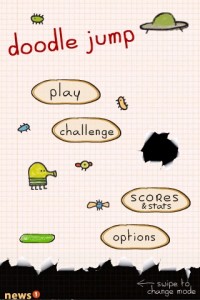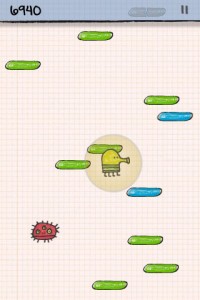 It seems that I’m a bit late to the Doodle Jump boat, but I’m no less addicted. Like the millions of Doodle Jump fans around the world, I’ve logged countless hours guiding Doodle up an endless path of platforms, dodging alien monsters and hoping for boosts from rockets and propeller hats.
It seems that I’m a bit late to the Doodle Jump boat, but I’m no less addicted. Like the millions of Doodle Jump fans around the world, I’ve logged countless hours guiding Doodle up an endless path of platforms, dodging alien monsters and hoping for boosts from rockets and propeller hats.
Doodle Jump advertises itself as “Doodle Jump – BE WARNED: Insanely Addictive!” and does not fail to deliver. But why? How can something so simple be so addicting to so many people?
For those of you who aren’t familiar with Doodle Jump, it’s a platform game created by Lima Sky that was released worldwide in April of 2009. By June of 2010, the game had already sold over 5 million copies, continuing to generate nearly 30,000 downloads a day.
![]() At this point, you might be thinking that the game must be epic. Dozens of levels, tons of tough enemies, tricky puzzles, customization galore. But you’d be wrong. Gameplay consists of guiding a green four-legged creature up an endless array of platforms without falling. The higher Doodle gets, the higher your score. That’s it.
At this point, you might be thinking that the game must be epic. Dozens of levels, tons of tough enemies, tricky puzzles, customization galore. But you’d be wrong. Gameplay consists of guiding a green four-legged creature up an endless array of platforms without falling. The higher Doodle gets, the higher your score. That’s it.
So back to my original question. Why is that fun? And more importantly, why is that repeatedly fun? Such a simple and repetitive action could get boring fast, but this game is different. There seem to be a lot of hidden factors that make Doodle Jump the runaway success that it is.
Here are my takes on why the game is so fun:
1. Doodle Jump is easy to learn.
Learning how to play Doodle Jump takes less than 5 seconds. Doodle’s movement up the platforms is intuitive, and his falling in the absence of a platform makes sense. Thus, within seconds of having the game in hand, a new player can grasp the concepts and goal of the game and can make plans to improve.
2. Doodle Jump is quick.
Life moves fast. Between work, school, errands, and bills, who has time for long, drawn-out games anymore? Instead, pull out Doodle Jump – infinite fun within a finite time period. Depending on the player’s skill, each game takes just seconds to complete. Waiting for a bus? Stuck in traffic? Looking for a noncommittal avenue toward endless procrastination? Doodle Jump can fill in any and all time voids, long and short.
Unlike Mario, Doodle traverses a different path every game. The basic platforms, enemies, and bonuses remain the same, but they occur in different places and at different times, keeping the player alert.
4. Predictability and surprise are well balanced.
Despite the seeming randomness of platform, enemy, and bonus placement, Doodle Jump is fairly predictable. Each game starts with rows upon rows of closely placed stationary platforms, ensuring minimal chances of falling. Difficulty ramps up steadily, first with the introduction of moving and breakable platforms, and then with disappearing and one-jump platforms. Eventually, the platforms spread out, forcing players to think on their feet and make split-second decisions.
5. Doodle Jump is difficult to master.
Like chess, Doodle Jump is easy to learn but difficult to master. Why? Because the game takes skill. Given a certain framework and set of restrictions, players must make decisions and then learn from those decisions to improve. Players get to level up, and that’s definitely addicting.
So the moral of the story? Doodle Jump is a runaway success because it is simple in all the right places and complex in all the right places. If you haven’t already, I definitely recommend that you give Doodle Jump a shot. But be warned: it’s insanely addictive!


